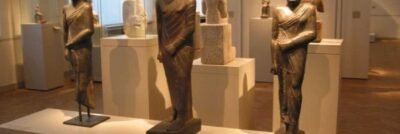

The ancient Egyptians used pottery for burial purposes, to contain those interior parts of the body which were removed before embalming. Four vases, which were sometimes deposited with the mummied body, contained the stomach, the heart and lungs, the liver, and the smaller intestines. These were generally made of stone, but sometimes of pottery. Pottery was used also in much the same way we use modern kitchen containers or plastic.
The study of pottery has also been very important in studying regional development and trade. We are today finding more and more evidence of Egypt’s influence in the region by pot shards. For example, pre-dynastic sites in the Palestinian region have yielded pottery made of Nile mud, and thus we are able to trace Egyptian trade and settlements. In addition, modern archaeological science has provided new tools to analyze the content of pottery, thus giving us insight into the use of various pottery items.
The pottery of pre-dynastic Egypt was often of a surprisingly fine quality. Badarian period pottery was made without the use of a potter’s wheel, and it was usually the woman who turned out the pottery.
Not until the Old Kingdom do we find the invention of the potter’s wheel in Egypt. At first this device was a simple turntable, but later evolved into a true potter’s wheel, requiring better preparation of the clay and more control during firing. It should be noted that these potter’s wheels were hand turned, and that the kick wheel variety was probably not developed until the Persian or Ptolemaic periods, though there is some disagreement among Egyptologists on this matter.
The other major type of pottery was made from ‘marl clay’, best known from material found around Qena in Upper Egypt. This type of pottery was usually thought superior to the common Nile mud pottery, and so it was often used for decorative and other functions. This type of pottery was often burnished, leaving a shiny surface similar to a glaze. However, true glazed pottery does not appear until Roman times. Further division of pottery involves the analysis of additional material added to the basic pottery fabric, known as filler or temper, as well as natural impurities in the clay.


Very interesting article. It pleases me to know we still use pottery which is being used for long time ago.